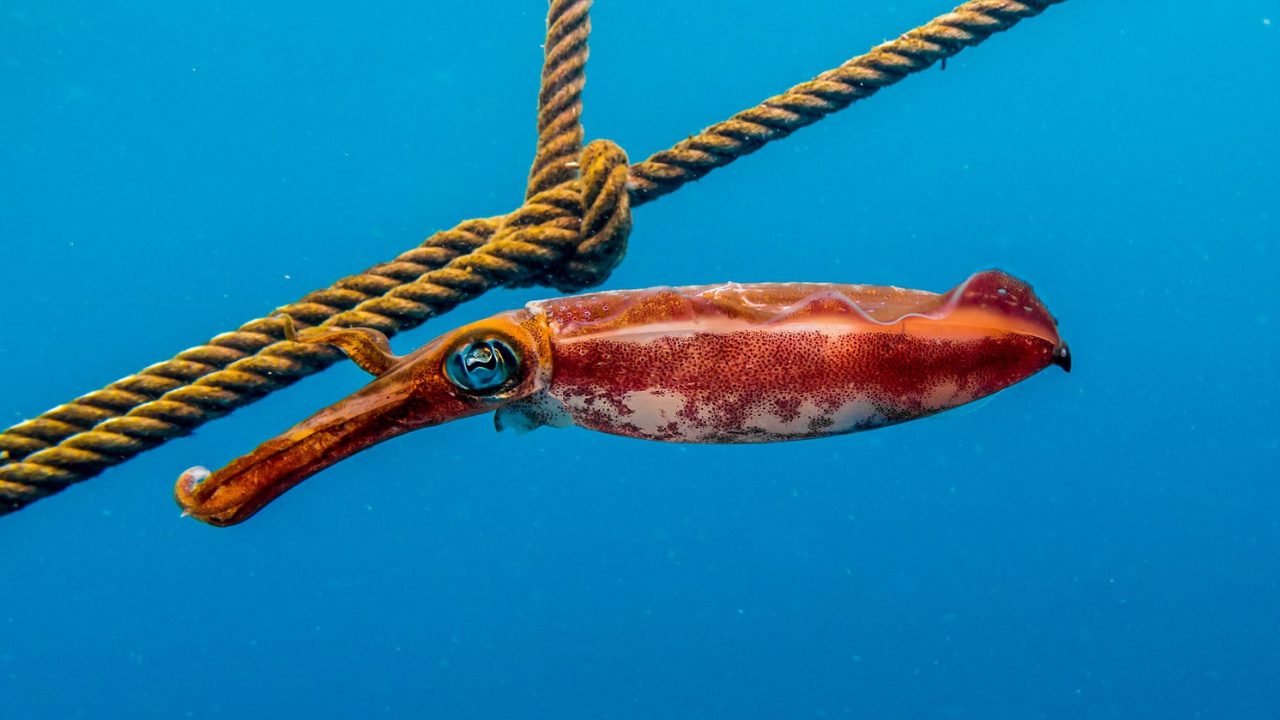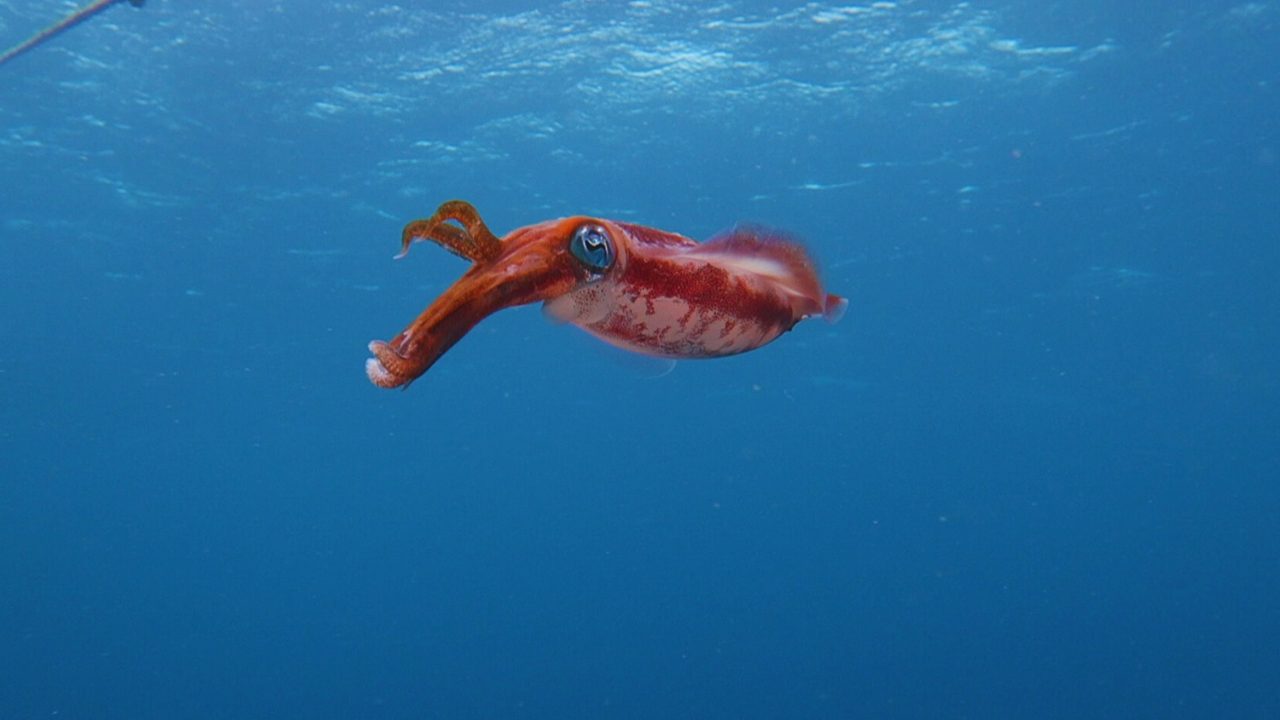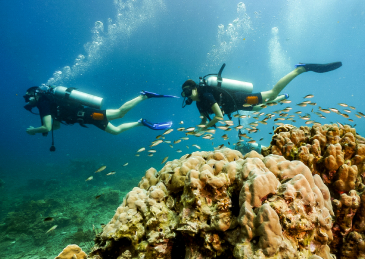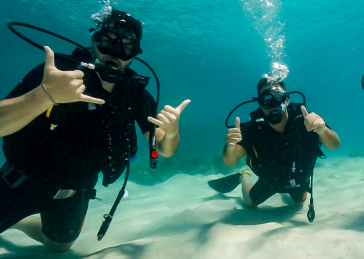Modified 9th June 2025
Squid Koh Tao: The Complete Guide to Bigfin Reef Squid Encounters
The squid around Koh Tao represent some of the ocean’s most extraordinary creatures, combining alien intelligence with breathtaking visual displays. These Bigfin Reef Squid, also known as oval squid or glitter squid, showcase abilities that seem almost supernatural – from instantaneous color transformations to complex social behaviors that researchers continue studying. Understanding when, where, and how to encounter these mesmerizing cephalopods transforms ordinary night dives into unforgettable wildlife experiences that highlight the incredible marine life diversity around Koh Tao.

Understanding Bigfin Reef Squid: Masters of Disguise
The squid Koh Tao divers encounter most frequently are medium-sized cephalopods, typically reaching 30-40 cm in length, though exceptional specimens approaching 50 cm have been documented around the island. Their distinctive wide fins run nearly the entire length of their mantle, creating an oval or diamond-shaped outline when viewed from above – a key identifying feature that distinguishes them from other squid species in Thai waters. For those planning to experience these incredible encounters, understanding the best time to dive around Koh Tao significantly increases your chances of memorable squid sightings.
What truly sets these creatures apart is their remarkable skin, covered in specialized cells called chromatophores (for color), iridophores (for iridescence), and leucophores (for white reflections). This adaptable skin serves as both camouflage and communication medium, allowing squid around Koh Tao to blend seamlessly into various environments or broadcast their intentions to others of their kind. These remarkable adaptations represent just one example of the diverse marine life behaviors that make Koh Tao a world-class diving destination.
Squid Behavior Around Koh Tao
Best Dive Sites for Squid Koh Tao Encounters
| Dive Site | Depth Range | Best Time | Squid Behavior Commonly Observed |
|---|---|---|---|
| Twins | 8-25m | Night dives | Hunting behavior in sandy channels |
| Japanese Gardens | 5-12m | Dusk transitions | Emerging from daytime resting spots |
| White Rock | 12-30m | Full moon periods | Mating displays and egg-laying |
| Shark Island | 5-18m | Evening/night | Group feeding on small fish schools |
| Southwest Pinnacle | 15-35m | Night dives | Undisturbed natural behavior |
Expert Tips for Successful Squid Koh Tao Encounters
- Move Slowly: Quick movements startle these sensitive creatures, causing them to flee or display alarm coloration. Gentle, deliberate movements yield longer observations.
- Use Red Light: Many night dive guides equip divers with red lights or red filters. Red wavelengths disturb marine life less than white light, allowing closer approaches.
- Look for Eye Reflection: The reflective quality of squid eyes often reveals their presence before their bodies become visible in darkness.
- Watch Sand-Water Boundaries: Bigfin Reef Squid often hunt along transitions between sandy bottom and water column.
- Maintain Neutral Buoyancy: Excellent buoyancy control prevents accidental contact and allows for extended observation periods.

Squid Intelligence and Communication
What makes squid Koh Tao encounters particularly memorable is the clear intelligence behind their behaviors. Like their octopus cousins, squid possess highly developed brains relative to other invertebrates, capable of learning, problem-solving, and potentially recognizing individual divers who visit their territories regularly.
Their neural organization features a distributed nervous system with a central brain and additional processing centers in their arms, yet they display unmistakable signs of advanced cognition. Their ability to rapidly assess threats, coordinate hunting in groups, remember locations, and engage in complex mating rituals all point to sophisticated information processing beyond simple instinctual responses.
Test Your Squid Koh Tao Knowledge
How Well Do You Know Bigfin Reef Squid?
Test your understanding of squid behavior around Koh Tao:
Squid Koh Tao Quick Facts
Conservation Status and Threats
Despite their remarkable adaptations and intelligence, Bigfin Reef Squid face various challenges in the waters around Koh Tao and throughout their range in the Indo-Pacific region. Their short lifespan makes them particularly vulnerable to environmental pressures.
Commercial fishing targets squid as popular seafood throughout Asia. Their short lifespan makes populations vulnerable to overfishing with limited recovery time.
Coral reef degradation from climate change, pollution, and physical damage impacts their hunting grounds and egg attachment sites.
Increasing coastal development and artificial light can disrupt natural behavioral patterns of these nocturnal creatures.
Plastic pollution poses risks through direct ingestion and damage to habitats squid depend on for successful reproduction.
Positive Conservation Factors: Their rapid reproduction allows relatively quick population recovery, increasing night diving tourism creates economic incentives for protection, and conservation zones around Koh Tao provide sanctuary for breeding populations.
Ready to witness the mesmerizing intelligence and color displays of Bigfin Reef Squid in their natural habitat?
La Bombona Diving specializes in night diving experiences that maximize your chances of unforgettable squid encounters around Koh Tao’s premier dive sites. Planning your trip? Check out our comprehensive guide on how to get to Koh Tao from anywhere in Thailand to make your squid diving adventure seamless.
- Expert night dive guides trained in cephalopod behavior
- Specialized red-light equipment for optimal squid observation
- Small group sizes for better wildlife encounters
- Access to prime squid habitats around Koh Tao
- Comprehensive marine life briefings before each dive
- Professional underwater photography services available
- Conservation-focused approach to marine encounters
- Flexible scheduling for optimal timing
Fun Dive Experiences: ฿2000 for 2 dives – Specialized equipment and expert guidance included
Book Your Squid Adventure TodayProfessional instruction | Red-light equipment provided | Small groups for better wildlife viewing
Frequently Asked Questions About Squid Koh Tao
Dive with LBD: Your Gateway to Underwater Exploration
Whether you’re a curious beginner or a seasoned pro, our school is your portal to the wonders of scuba diving. Join us into the world beneath the waves.
READY TO GET STARTED?
Check our diving courses in Koh Tao



